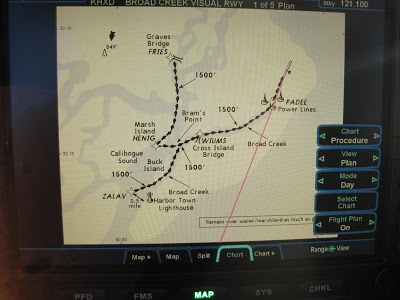After 300+ hours flying behind the R9 screens, I thought I knew everything there was to know about R9. But at the risk of sounding like an “old dog”, yesterday at the R9 User Group Meeting in Hilton Head, I learned a couple of cool new tricks!
The weather was excellent and Hilton Head is only 270 miles away… So the plan was for an early morning journey, which would get me there in time for the 08:30 planned start. The trip there was a rather uneventful flight. A direct climb to 17k FT using the IAS climb feature of DFC100, followed by a totally peaceful IFR flight. In fact, the skies were so empty at that hour, that I was making “excuses” to talk to ATC just to ensure that my radio was working properly!
When I got closer to Hilton Head Airport, I checked out the charts and found something unusual. Instead of the typical cadre of precision approaches, they had something called the “Broad Creek Visual Approach” procedure.

I had never heard of a “Visual Approach Procedure”. But it looked rather simple and I was eager to try it. I asked ATC for a descent and a clearance for this funky approach. They cleared me “as requested” and told me to “Report when I had the lighthouse in sight”. Moments later, I saw the infamous lighthouse and proceeded to follow the approach course at 1500 FT along the water. It was quite a sight following a river at such a low altitude.
I found it quite ironic that in order to get to a user group for a very high tech product, I flew a very old fashioned (and low tech) flight along a river using a lighthouse as a landmark!
After the meeting, I was so excited about the tips, tricks and “gems” that were discussed and was eager to try them myself in flight.
The one “gem” that intrigued me the most, was the idea of a “Pseudo Approach”. The basic idea is that when flying to any runway (regardless airport ground equipment), you can use R9 altitudes constraints / course offsets in conjunction with the DFC100 Vertical Navigation features to create a simulated GPS approach with a glideslope. Obviously, this is not a legal FAA sanctioned procedure. Nor is it as accurate as a real published instrument procedure. However, when the real thing is not available, it is certainly much better and safer than having nothing. Here is a short video clip that shows my first attempt doing this:
Now after learning a few R9 tricks, I can’t wait till next months’ CPPP training course in Atlanta so I can hopefully learn some cool Cirrus tricks!
Cheers,
== T.J.==
